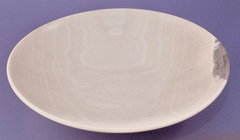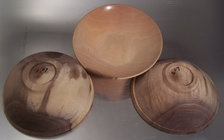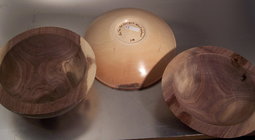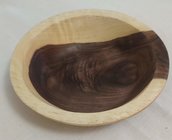-
Beware of Counterfeit Woodturning Tools (click here for details) -
Johnathan Silwones is starting a new AAW chapter, Southern Alleghenies Woodturners, in Johnstown, PA. (click here for details) -
Congratulations to Peter Jacobson for "Red Winged Burl Bowl" being selected as Turning of the Week for April 29, 2024 (click here for details) -
Welcome new registering member. Your username must be your real First and Last name (for example: John Doe). "Screen names" and "handles" are not allowed and your registration will be deleted if you don't use your real name. Also, do not use all caps nor all lower case.
You are using an out of date browser. It may not display this or other websites correctly.
You should upgrade or use an alternative browser.
You should upgrade or use an alternative browser.
Walnut Sapwood
- Thread starter Kent Reisdorph
- Start date
I think it goes dark as it ages. I haven't turned walnut in a while. I do react to it now days. I think all sap wood does. Now, why it does is another thing....
robo hippy
robo hippy
It will darken somewhat with age, but I don't think it will ever convert into heartwood. The sapwood is effectively dead once it has lost a significant portion of its moisture. Most darkening is going to result from air oxidation, though there could be other factors involved as well.
I have had it explained to me that it is just like an avocado or an apple. It will turn brown over time. Since citric acid helps with an apple it also helps with woods like walnut and cherry to keep the white whiter. Even with lemon juice it will start to darken but the lemon juice will slow the progression and leave it whiter than with no treatment. HOW?? I slather the lemon juice all over the piece when I make my final cuts. Let it sink in and penetrate. As the wood dries out, some of the citric acid is left behind. After a few days I start the sanding sequence. After the last grit of sanding I slather on more lemon juice. I keep a bottle of "real Lemon" juice on my bench dedicated to this. Again after the last sanding and saturation with lemon juice you have to let it dry again. This will likely raise the grain so another light sanding with 400 or 600 grit will make it smooth again. I have tested this years ago, on two bowls from the same tree, with-and-without lemon juice, and the results are amazing. The bright white will fade but it will retain the contrast.It will darken somewhat with age, but I don't think it will ever convert into heartwood. The sapwood is effectively dead once it has lost a significant portion of its moisture. Most darkening is going to result from air oxidation, though there could be other factors involved as well.
I have had it explained to me that it is just like an avocado or an apple. It will turn brown over time. Since citric acid helps with an apple it also helps with woods like walnut and cherry to keep the white whiter. Even with lemon juice it will start to darken but the lemon juice will slow the progression and leave it whiter than with no treatment. HOW?? I slather the lemon juice all over the piece when I make my final cuts. Let it sink in and penetrate. As the wood dries out, some of the citric acid is left behind. After a few days I start the sanding sequence. After the last grit of sanding I slather on more lemon juice. I keep a bottle of "real Lemon" juice on my bench dedicated to this. Again after the last sanding and saturation with lemon juice you have to let it dry again. This will likely raise the grain so another light sanding with 400 or 600 grit will make it smooth again. I have tested this years ago, on two bowls from the same tree, with-and-without lemon juice, and the results are amazing. The bright white will fade but it will retain the contrast.
Interesting. I knew about lemon juice to remove walnut stains from my hands, but never thought about trying it on the wood itself.
Indeed, citric acid (citrate) is a reducing agent that will inhibit air oxidation. This will certainly slow the process, though eventually the citrate itself will oxidize and won't be doing anything.I have had it explained to me that it is just like an avocado or an apple. It will turn brown over time. Since citric acid helps with an apple it also helps with woods like walnut and cherry to keep the white whiter. Even with lemon juice it will start to darken but the lemon juice will slow the progression and leave it whiter than with no treatment. HOW?? I slather the lemon juice all over the piece when I make my final cuts. Let it sink in and penetrate. As the wood dries out, some of the citric acid is left behind. After a few days I start the sanding sequence. After the last grit of sanding I slather on more lemon juice. I keep a bottle of "real Lemon" juice on my bench dedicated to this. Again after the last sanding and saturation with lemon juice you have to let it dry again. This will likely raise the grain so another light sanding with 400 or 600 grit will make it smooth again. I have tested this years ago, on two bowls from the same tree, with-and-without lemon juice, and the results are amazing. The bright white will fade but it will retain the contrast.
My experience has been that wet sap wood will dicolor but that once it's dry the color is pretty stable.
Lemon juice/citric acid can help prevent the darkening. Lemon juice contains 5-8% citric acid. You can buy citric acid powder on amazon and mix up more concentrated solutions; it's soluble up to 50%. Be careful to protect against chemical burns if you get much over 10%.
Lemon juice/citric acid can help prevent the darkening. Lemon juice contains 5-8% citric acid. You can buy citric acid powder on amazon and mix up more concentrated solutions; it's soluble up to 50%. Be careful to protect against chemical burns if you get much over 10%.
The lemon juice will remove metal stains from wood, very quickly if you put it on while the wood is still green and wet. When dry, it will take longer. It also acts like a bleach on dry wood and will lighten the color a bit, so if you don't wet the entire piece, it will show drip lines.
robo hippy
robo hippy
That is my experience also however my experience is limited to a couple of years.My experience has been that wet sap wood will dicolor but that once it's dry the color is pretty stable.
I did try to keep Black Walnut sapwood from darkening up, so I turned a shallow dish from fresh Black Walnut, fairly thin and dried it quickly, crossed my fingers and hoped it would not split.
So I got this dish of of Black Walnut Sapwood dried, and still fairly white, there was just a small part that was darker wood, and I found that even this little part of dark wood did influence the overall color over time, as you can see in the pictures.
The color did change a bit as the last 2 pictures show of the less than half a year old turning, not bad, but it was not the fresh white from the just turned wood.
Any liquid will leach the dark hardwood into the sapwood, the reason sawyers will steam fresh saw wood for a time to get all of he wood "equal" in color, I find that air dried Walnut looks better than the steamed Walnut, but there is less dark wood of course.
Here is the turned Walnut sapwood after it was dried.


Here's what it looked like after a few months in a normal lighted room in our house.


I did not find the outcome worth the effort, so I left it by that one experiment
You can bleach the wood, with 2 part wood bleach, normal household bleach does not affect wood color, it does affect color like used in fabric etc.
To remove Iron from wood you use Oxalic Acid, I have used it (sill have some sitting) it does work op to a point, basically only surface stain/iron, deeper stains not affected (think iron in Red Oak grain)
So I got this dish of of Black Walnut Sapwood dried, and still fairly white, there was just a small part that was darker wood, and I found that even this little part of dark wood did influence the overall color over time, as you can see in the pictures.
The color did change a bit as the last 2 pictures show of the less than half a year old turning, not bad, but it was not the fresh white from the just turned wood.
Any liquid will leach the dark hardwood into the sapwood, the reason sawyers will steam fresh saw wood for a time to get all of he wood "equal" in color, I find that air dried Walnut looks better than the steamed Walnut, but there is less dark wood of course.
Here is the turned Walnut sapwood after it was dried.


Here's what it looked like after a few months in a normal lighted room in our house.


I did not find the outcome worth the effort, so I left it by that one experiment
You can bleach the wood, with 2 part wood bleach, normal household bleach does not affect wood color, it does affect color like used in fabric etc.
To remove Iron from wood you use Oxalic Acid, I have used it (sill have some sitting) it does work op to a point, basically only surface stain/iron, deeper stains not affected (think iron in Red Oak grain)
Last edited:
Very interesting, Leo. It does appear that that one spot of heartwood affected the surrounding sapwood.
In my experiences with freshly cut hardwoods, the sap wood is much wetter, (hence the name) and softer than the adjacent and sometimes darker heartwood. From earlier readings, it is responsible for nutrient transfer both upward and downward in a living tree.
Regarding heartwood, here is an excerpt from Wikipedia, under the heading: Wood
Heartwood (or duramen[12]) is wood that as a result of a naturally occurring chemical transformation has become more resistant to decay. Heartwood formation is a genetically programmed process that occurs spontaneously. Some uncertainty exists as to whether the wood dies during heartwood formation, as it can still chemically react to decay organisms, but only once.[13]
The term heartwood derives solely from its position and not from any vital importance to the tree. This is evidenced by the fact that a tree can thrive with its heart completely decayed. Some species begin to form heartwood very early in life, so having only a thin layer of live sapwood, while in others the change comes slowly. Thin sapwood is characteristic of such species as chestnut, black locust, mulberry, osage-orange, and sassafras, while in maple, ash, hickory, hackberry, beech, and pine, thick sapwood is the rule.[14] Some others never form heartwood.
Heartwood is often visually distinct from the living sapwood, and can be distinguished in a cross-section where the boundary will tend to follow the growth rings. For example, it is sometimes much darker. Other processes such as decay or insect invasion can also discolor wood, even in woody plants that do not form heartwood, which may lead to confusion.
Regarding heartwood, here is an excerpt from Wikipedia, under the heading: Wood
Heartwood (or duramen[12]) is wood that as a result of a naturally occurring chemical transformation has become more resistant to decay. Heartwood formation is a genetically programmed process that occurs spontaneously. Some uncertainty exists as to whether the wood dies during heartwood formation, as it can still chemically react to decay organisms, but only once.[13]
The term heartwood derives solely from its position and not from any vital importance to the tree. This is evidenced by the fact that a tree can thrive with its heart completely decayed. Some species begin to form heartwood very early in life, so having only a thin layer of live sapwood, while in others the change comes slowly. Thin sapwood is characteristic of such species as chestnut, black locust, mulberry, osage-orange, and sassafras, while in maple, ash, hickory, hackberry, beech, and pine, thick sapwood is the rule.[14] Some others never form heartwood.
Heartwood is often visually distinct from the living sapwood, and can be distinguished in a cross-section where the boundary will tend to follow the growth rings. For example, it is sometimes much darker. Other processes such as decay or insect invasion can also discolor wood, even in woody plants that do not form heartwood, which may lead to confusion.
I have heard it expressed like this, "Sapwood is the living wood. Heartwood is the dead wood. Each year, a ring of sapwood dies and becomes heartwood. A new layer of sapwood is formed."

